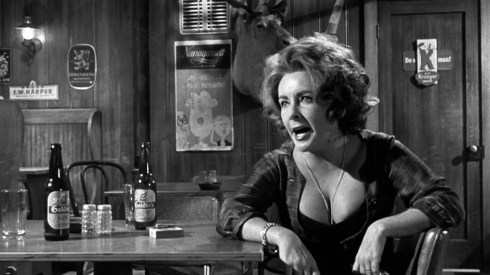
*THE CEMETERY -PILOT TV movie AIR DATE NOV.8, 1969
*THE DEAD MAN-AIR DATE DEC. 16, 1970
*CERTAIN SHADOWS ON THE WALL-DEC.30, 1970
*THE DOLL-AIR DATE JAN.13, 1971
*A FEAR OF SPIDERS -AIR DATE OCT. 6, 1971
*COOL AIR-AIR DATE DEC.8, 1971
*GREEN FINGERS-AIR DATE JAN.8, 1972
*GIRL WITH THE HUNGRY EYES AIR DATE OCT.1, 1972
*SOMETHING IN THE WOODWORK AIR DATE JAN.14, 1973
Next time up, The Tune in Dan’s Cafe, Lindenmann’s Catch, A Question of Fear, The Sins of the Father, Fright Night and There Aren’t Any More McBanes.
Available on DVD: with Season 2 Audio Commentary from Guillermo Del Toro and from historians Scott Skelton and Jim Benson and Season 3 also with Audio Commentary from historians Scott Skelton and Jim Benson.
There will be no need for spoilers, I will not give away the endings "¦
The way the studio wants to do it, a character won't be able to walk by a graveyard, he'll have to be chased. They're trying to turn it into a Mannix in a shroud."”Creator Rod Serling
“Good evening, and welcome to a private showing of three paintings, displayed here for the first time. Each is a collectors’ item in its own way – not because of any special artistic quality, but because each captures on a canvas, and suspends in time and space, a frozen moment of a nightmare.”-Rod Serling Host
With the major success of The Twilight Zone (1959-1964), after it was canceled in 1964, Rod Serling continued to work on various projects. He wrote the screenplays for the movie versions of Pierre Boulle's Planet of the Apes and The Man based on the novel by Irving Wallace. In 1970 he created a new series, Night Gallery which was tales of the macabre based on various mystery/horror/fantasy writers, H.P Lovecraft, Algernon Blackwood and even Serling himself. The show was produced by Jack Laird and Rod Serling. The show ran six episodes each, part of four dramatic series under the umbrella title Four-In-One. In 1971, it appeared with its own vignettes on NBC opposite Mannix. In 1971 the Pilot for the show had three of the most powerful of the series. The Cemetery starring Ossie Davis, Roddy McDowall, and George Macready. Eyes star Hollywood legend Joan Crawford plays an unpleasant tyrant who is blind and is willing to rob the sight of another man in order to see for a short period of time. The segment was directed by Steven Spielberg. The last playlet starred Norma Crane and Richard Kiley as a Nazi who is hiding out in a South American country and dreams of losing himself in a little boat on a quiet lake depicted in a painting at the local art museum.
Then Night Gallery showcased an initial six segments and the hour-long series consisted of several different mini teleplays. In its last season from 1972-1973, the show was reduced to only a half hour.
Night Gallery differed from The Twilight Zone which was comprised of science fiction and fantasy narratives as it delved more into the supernatural and occult themes. The show has a unique flavor in the same way Boris Karloff introduced each one of Thriller's divergent stories, Rod Serling would introduce each episode surrounded by his gallery of macabre and morbid paintings by artist Gallery Painter: Tom Wright Serling would open his show with a little soliloquy about life, irony and the upcoming tale of ghoulish delights.
Rod Serling was not a fan of Night Gallery and did not have the revelatory passion and inducement to plug the show the way he did for The Twilight Zone, in fact, the series was panned by the critics. Two of the shows Serling wrote were nominated for Emmys, "They're Tearing Down Tim Riley's Bar" starring William Windom and Diane Baker, and The Messiah of Mott Street " starring Edward G. Robinson.
From Gary Gerani-Fantastic Television: A Pictorial History of Sci-Fi, the Unusual and The Fantastic
"No stranger to the interference of sponsors, networks and censors, Serling once again found himself locked by contact into an untenable situation..{"¦}"¦ He owned Night Gallery, created it and it was sold to network and audience on his reputation . The competitor on CBS was Mannix, a formula private-eye shoot-and rough-"˜em up. Serling felt that NBC and Universal were doing their best to imitate Mannix, with an emphasis on monsters, chases and fights. They turned down many of his scripts as "too thoughtful" Serling lamented. "They don't want to compete against Mannix in terms of contrast, but similarity." Not only was Serling unable to sell them scripts he was also barred from casting sessions, and couldn't make decisions about his show"”he had signed away creative control. As a result he tried to have his name removed from the title, but NBC had him contract-bound to play host and cordially to introduce the parasite to the TV audience."
Continue reading “Rod Serling’s Night Gallery 9 Terrifying Halloween Treats!”




























































![Anna Lucasta (1958) | Pers: Eartha Kitt, Sammy Davis Jr | Dir: Arnold Laven | Ref: ANN040AE | Photo Credit: [ United Artists / The Kobal Collection ] | Editorial use only related to cinema, television and personalities. Not for cover use, advertising or fictional works without specific prior agreement](https://i0.wp.com/thelastdrivein.com/wp-content/uploads/2015/07/tumblr_lvnaeyvi341r1a8w8o1_500.jpg?resize=490%2C589&ssl=1)













































